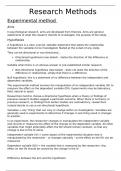Summary
Summary AQA A-level Psychology Research Methods Revision Notes
- Course
- Institution
- Book
This document is detailed revision notes with all you could ever need to know on the whole AQA A-level Psychology Research Methods topic, including AO1 and AO3 content. The notes are subdivided into the subtopics used by the textbook. They include the content from the textbook, which has been combi...
[Show more]




